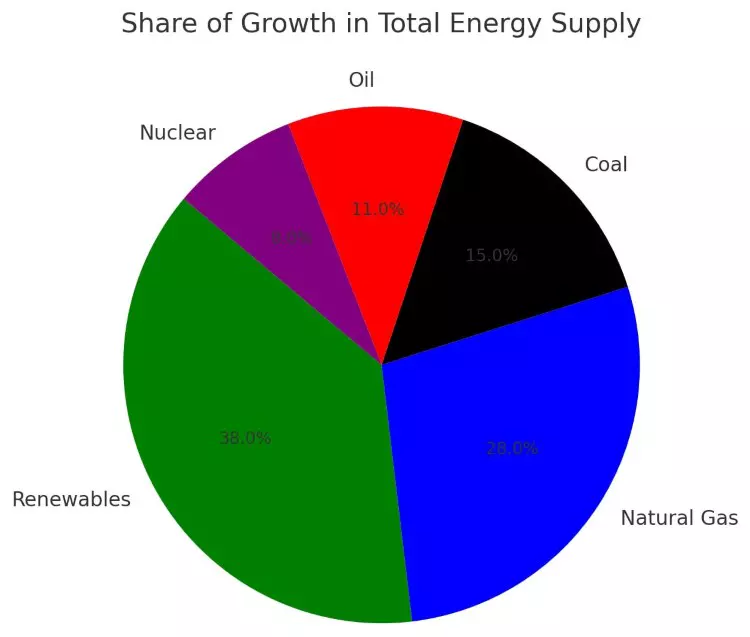The world’s demand for energy is growing at an unprecedented rate. As electricity consumption surges due to extreme weather, electrification, and digitalization, the question arises: Can renewable energy meet this challenge? What does the future hold for Energy Transition 4.0? While renewables are gaining prominence, fossil fuels—especially natural gas—still play a critical role, with emerging economies like China and India driving demand. As electric vehicles (EVs) increase electricity consumption and coal remains essential in some regions, balancing growth, sustainability, and emissions reduction remains a global challenge. Let’s explore the evolving energy landscape and the outlook presented in the Global Energy Review 2025 by the International Energy Agency (IEA).
Global energy demand: a rapid rise
According to the Global Energy Review 2025, global energy demand rose by 2.2% in 2024, exceeding the past decade’s average growth rate. The power sector led the increase, for example China led global demand growth in absolute terms in 2024. Key drivers include extreme temperatures, electrification, and digitalization. Renewables contributed the most, accounting for 38% of this growth. Emerging economies, particularly China and India, fueled most of the rise in energy consumption.
China has made significant progress in renewable energy, reaching a generation capacity of 1.41 billion kW by the end of 2024, surpassing 40% of its total energy output. To streamline energy pricing, China is shifting toward market-based mechanisms. Starting June 1, 2025, renewable energy plants will sell electricity at market rates, gradually phasing out price controls. This transition aims to balance supply and demand more effectively while reducing risks to the energy system.
Oil and natural gas: slower growth but still dominant
Global oil demand increased by only 0.8% in 2024, down from 1.9% in the previous year. According to the Global Energy Review 2025, this marks a slowdown in fossil fuel consumption. Oil demand for road transport declined, particularly in China and advanced economies, while aviation and petrochemical industries saw growth. Oil’s share in global energy demand fell below 30% for the first time, a sharp drop from its peak of 46% five decades ago.
Among fossil fuels, natural gas saw the strongest growth, rising by 2.7% in 2024. China led this increase with a growth rate exceeding 7%, followed by the U.S. with a 2% rise, while the European Union experienced modest gains. Despite its role as a “bridge fuel,” natural gas faces growing competition from renewables as nations work to cut carbon emissions (Global Energy Review 2025).
In the U.S., energy policy reflects this tension. U.S. Secretary of Energy Chris Wright recently stated that oil and gas cannot be replaced by renewables in the short term. He criticized climate-related restrictions, arguing they harm the economy and could drive industrial shifts to Asia, where energy costs are lower. This underscores the challenge of balancing energy transition goals with economic stability.
Coal: a persistent power source
Coal demand increased by 1% in 2024, primarily due to power generation, with high temperatures boosting electricity needs, particularly for cooling. China and India were the largest consumers, driving most of the global increase. Despite its declining global share, coal remains a crucial energy source in countries like China, where it accounts for 58% of total consumption. While many nations push for greener energy, coal’s affordability and reliability keep it in use, as highlighted in the Global Energy Review 2025.

Source of data: Global Energy Review 2025
The shift to nuclear and renewable energy
The Global Energy Review 2025 highlights a shift toward nuclear and wind power. In 2024, global nuclear capacity grew by 7 GW, a 33% increase from 2023, adding 100 TWh of electricity to the grid. Wind and solar energy contributed 32% of global power generation, with a record-breaking 670 TWh increase, surpassing coal and gas in several countries. The shift toward cleaner energy sources is evident, with renewables and nuclear power playing leading roles in electricity generation.
Electric vehicles are also reshaping energy demand. In 2024, global EV sales surged by over 25%, making up one-fifth of all car sales. This trend is particularly strong in the U.S. and China, where EV adoption is high. As more EVs replace combustion-engine vehicles, electricity demand will continue to grow, further increasing reliance on renewable energy sources.
Renewable energy now leads global electricity generation. In 2024, renewables accounted for 80% of electricity generation growth, with solar PV and wind installations setting new records. Solar energy made up nearly 80% of new renewable capacity, accelerating the transition to a low-carbon energy system. This shift is reducing reliance on fossil fuels and aiding the decarbonization of the global energy mix. As a result, energy-related carbon dioxide emissions grew by just 0.8% in 2024, despite global economic growth exceeding 3%. Since 2019, the expansion of solar, wind, and nuclear power has prevented 2.6 billion tons of CO2 emissions annually—equivalent to 7% of total global emissions.
Navigating the energy transition: balancing growth, security, and sustainability
Unfortunately, energy efficiency improvements have slowed. From 2010 to 2019, global energy intensity improved by 2% annually, but this rate dropped to 1% in 2024. Factors such as energy-intensive growth in China and India and the use of less efficient fuels contributed to this slowdown. Despite the rise of renewables, fossil fuels—especially natural gas—remain essential in many regions. Balancing economic growth, energy security, and sustainability remains a key challenge as extreme weather and emissions targets shape the global energy landscape.
At New Polis, we’ve previously explored the complexities of transitioning to renewable energy and green policies, particularly through the case study of Germany’s energy shift.
Renewable energy is expanding rapidly, but oil and natural gas continue to play critical roles in global energy consumption. Oil remains vital for industries and transportation, particularly in emerging markets, though its growth is slowing due to the rise of EVs and cleaner technologies. Meanwhile, natural gas remains in high demand, particularly as LNG, serving as a bridge fuel during the energy transition. While renewables will shape the future of energy, natural gas will continue to provide stability in the coming years.
If you want to know how to make a profit from renewable energy in cities, read about it here.


